Speech The Australian Economy – Prospects for 2006 and Beyond

Malcolm Edey
Assistant Governor (Economic)
Address to the 2006 CEDA/Fujitsu Economic & Political Overview
Sydney –
Good morning and thank you to CEDA for the opportunity to speak today.
As you know, the Reserve Bank has had quite a lot to say about the economy just recently, particularly through our quarterly policy statement and half-yearly parliamentary appearance last week. That material is still very current, and in my presentation this morning I'm going to draw out a few of the main themes from those statements.
Let me start with some general observations about the current business cycle (Graph 1). Economists often focus very closely on short-term movements in the data, but it's important also to have a sense of where we are in relation to the overall business cycle. A good starting point is to compare Australia's three most recent periods of economic expansion, which began in the mid 1970s, the early 1980s and the early 1990s. The current expansion, which is now in its 15th year, is already roughly twice as long as the two previous ones. Average growth during the current expansion has been 3.7 per cent per annum, which is one of the best performances over this period in the developed world. It is true that this is not quite as high as the average growth rate achieved during the 1980s, but the current expansion more than makes up for that by its extended duration.
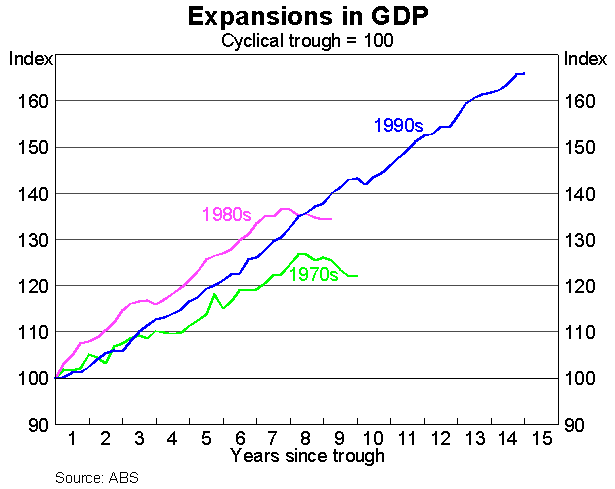
One of the benefits of a long expansion is that unused resources of both labour and capital are, over time, brought back into productive use. There are a number of different indicators that can be used to illustrate that. Businesses have for some time been reporting that capacity usage is high. For example, according to the NAB survey, which is broadly representative of the non-farm economy, the level of capacity utilisation at the end of last year was the highest since the survey began – exceeding the level reached in 1989, which was itself a cyclically strong year (Graph 2).
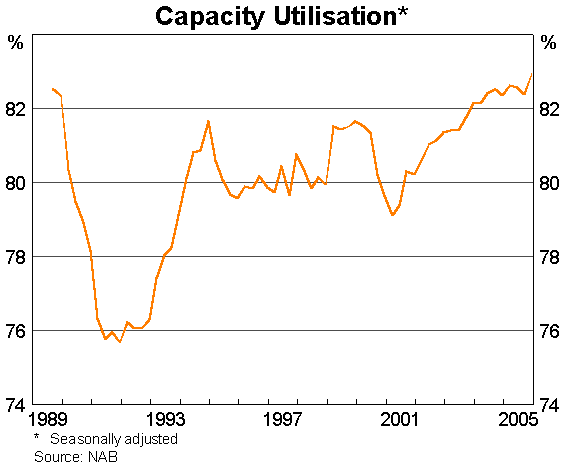
It is also clear that utilisation of labour has substantially increased over the course of the expansion. One indicator of that is the unemployment rate, which has come down from a peak of nearly 11 per cent in 1993 to an average of just over 5 per cent in the latest year (Graph 3). It is worth noting here that it is quite normal for the unemployment rate to fluctuate in the short term around its trend. There were a couple of periods where unemployment increased moderately during the current expansion, but the overall trend has been downwards, and this has brought the unemployment rate to around its lowest level since the 1970s.
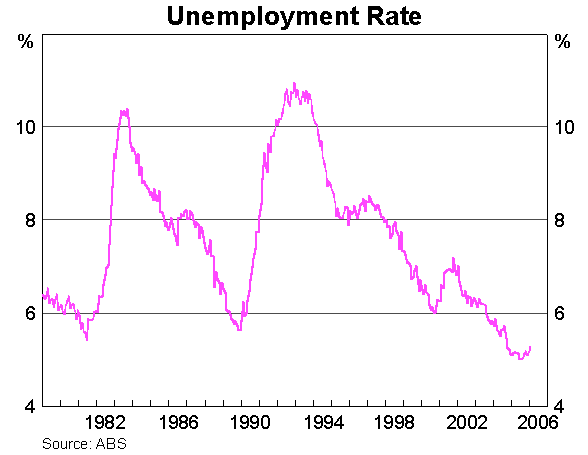
Consistent with the strong labour market, other indicators, particularly the business surveys, have been pointing to high levels of labour scarcity. Using the NAB survey, this point can be seen by looking at the way businesses respond to the question of what factors are significantly constraining their output (Graph 4). Throughout the history of this survey, the most popular response has almost always been ‘sales and orders’ – in other words a lack of demand. But for the past year or so, businesses have been in the unusual position of reporting that the main constraint was a lack of suitable labour.
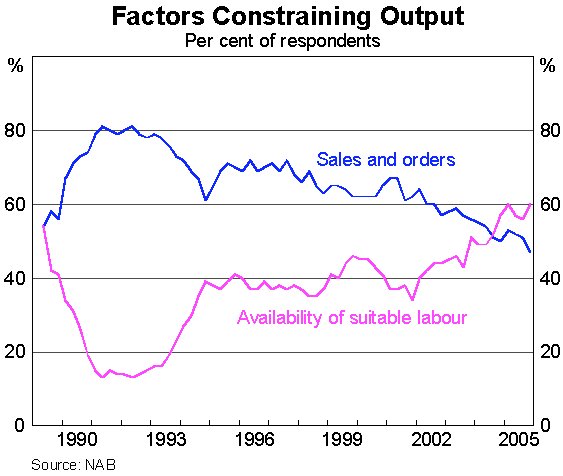
A survey of small and medium-sized businesses conducted by Sensis gives the same picture (Graph 5). In this survey the question is put slightly differently, with businesses being asked to nominate their main sources of general concern. It is interesting to note that the most consistently popular answer is ‘none’ – i.e. they are not worried about anything – a result that might serve as a useful corrective to gloomy economic reporting. The next two most popular responses typically have been ‘lack of work or sales’ and ‘finding quality staff’. As with the NAB survey, the number of businesses citing lack of sales is almost always the bigger of the two, but this ranking has been reversed in the past 12 to 18 months.
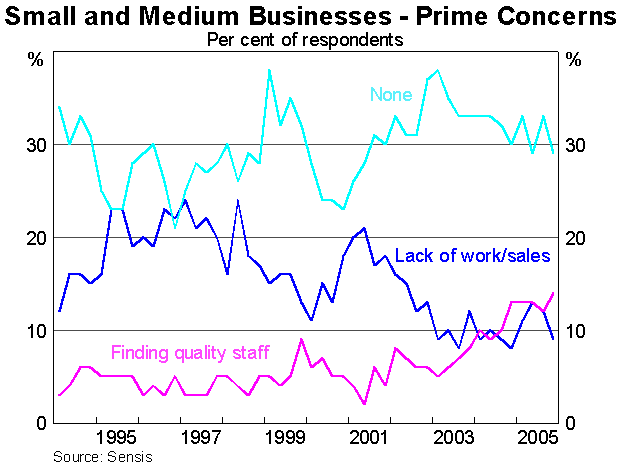
Overall then, the current expansion has been marked by good economic growth over an extended period, and this has brought about a significant re-employment of unused resources, both capital and labour. Referring to this in our recent policy statements, the Bank has been making the point that the economy is now operating with more limited margins of spare capacity than at earlier stages of the expansion. This is an important part of the background to the Bank's forecast of a rise in underlying inflation in the year ahead.
So much for the medium-term background. What are the factors shaping the outlook for growth in the period ahead? In addressing that, I will focus briefly on three main areas.
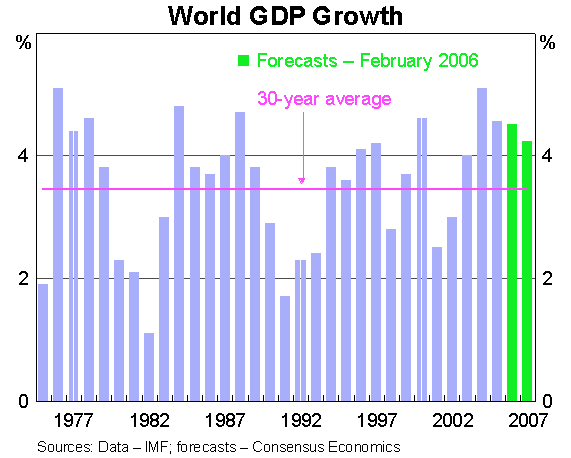
The first is the global business cycle (Graph 6). The world economy is currently in a solid expansion, and one which, on past experience, may still have a good way to run. Last year, world GDP is estimated to have grown by 4½ per cent, the third year in a row when growth has been above average. As well as the overall pace of growth, it is encouraging to note that the world recovery has been increasingly broadly based. Initially, it was led mainly by the US and China, and both of those economies are still performing well. But in addition to that, we are now seeing good growth in a number of other regions around the world. The latest figures for Japan showed growth of 4½ per cent over the past year, its fastest for more than a decade, and there are good signs that the structural problems of debt and deflation in Japan are being wound back. We are also seeing very good growth in other parts of east Asia and in India, Latin America and emerging Europe. Looking at the overall composition of world GDP growth, it is notable how much of the growth now is coming from outside the core of developed countries in North America, Japan and western Europe (Table 1).
| Share of world GDP* | 2005 Estimate |
2006 Consensus forecast |
2007 Consensus forecast |
|
|---|---|---|---|---|
| United States | 20.9 | 3.5 | 3.2 | 3.0 |
| Euro area | 15.3 | 1.4 | 2.0 | 1.8 |
| Japan | 6.9 | 2.8 | 2.3 | 2.2 |
| China | 13.2 | 9.9 | 9.0 | 8.5 |
| Other east Asia | 7.0 | 4.8 | 4.9 | 4.8 |
| India | 5.9 | 7.6 | 7.1 | 7.1 |
| Latin America | 7.2 | 4.3 | 4.1 | 3.8 |
| Emerging Europe | 7.0 | 5.5 | 5.5 | 5.4 |
| World | 100.0 | 4.6 | 4.5 | 4.2 |
|
*2004, at PPP exchange rates Source: data – IMF and Thompson Financial; forecasts – Consensus |
||||
The world outlook is never risk-free of course, and many observers have focused on possible risks to growth arising from high oil prices and from world current account imbalances. But there is little sign that these factors are holding back the global expansion at present, and most forecasters expect a further year of above-average growth in 2006. If anything, these forecasts have tended to edge up in recent months, in response to generally strong economic indicators in most countries. In general terms, then, the world economic situation is providing a favourable environment for growth in Australia.
The second area to highlight is the increase in Australia's terms of trade (Graph 7). This is closely related to the first point. One of the consequences of the strong global economy, and particularly the growth of Chinese industrial demand, has been sustained upward pressure on a range of commodity prices. Over the past three years this has lifted Australia's terms of trade by around 30 per cent, the largest cumulative increase that we have experienced since the early 1970s. It is not hard to appreciate that this provides a significant boost to incomes and spending. With exports representing about a fifth of GDP, each 10 per cent increase in the terms of trade adds about 2 per cent to the value of national income.
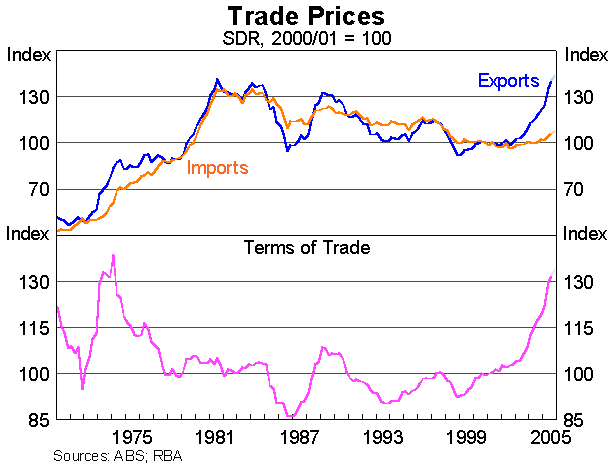
The expansionary effects of the rise in Australia's terms of trade can be seen particularly in the business sector (Graph 8). Businesses at the moment have strong balance sheets and they are well placed to take advantage of the current favourable conditions. Business investment is now undergoing a major upswing, having expanded by 18 per cent over the past year and at an average rate of 14 per cent over the past three years. Not surprisingly, the growth has been led by the resources sector. But given the high level of capacity utilisation across the economy as a whole, it is also not surprising to see a more broadly based pick-up in investment growth in a range of other industries. The broad strength of the business sector has been evident in the growth of corporate profits and in the performance of the share market. Share prices in the Australian market have outperformed those overseas in the past few years and, unlike most other major markets, have moved well beyond their 2000 peak.
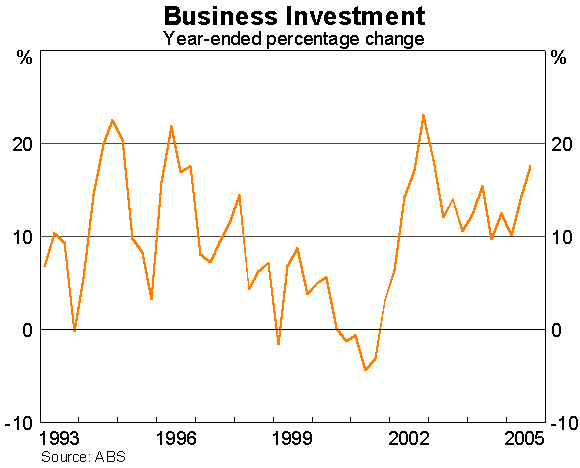
The third area to look at is household spending. In contrast to businesses, households have eased back on their spending growth in the past year or two (Graph 9). We can see this for example in the growth of retail sales and in household consumption, both of which are now running at below-average rates, after the unusually rapid growth seen a couple of years ago. The main factor behind this correction seems to be a process of balance-sheet adjustment, with households now adopting a more cautious approach towards the accumulation of additional debt. Household credit growth in the last two years has slowed down from a rate of over 20 per cent to be now running at a an annual rate of around 12 per cent. This adjustment has brought household credit growth back towards the lower end of its historical range, though still quite high in absolute terms. It means that households are still increasing their levels of debt, and their ratio of debt to income, but they are doing so at a slower pace than they were a couple of years ago.
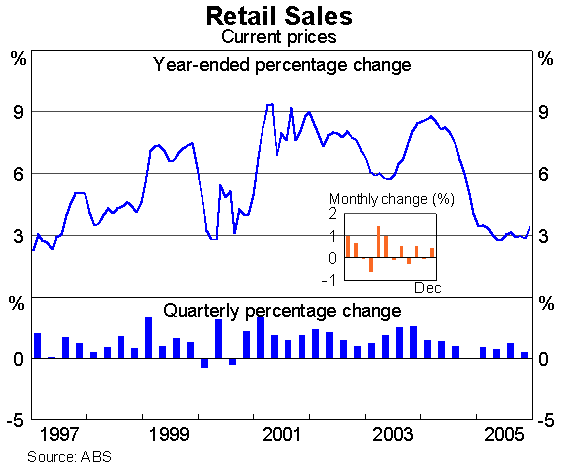
Another factor in the slowing of household spending has been the downturn in the housing construction cycle, which peaked in early 2004. Having said that, however, I should note that the current downturn in this sector is an unusually mild one compared with previous cycles (Graph 10). The overall level of housing construction activity, expressed as a proportion of GDP, is still only slightly below its recent peak, and higher than at most other times for which historical data exist.
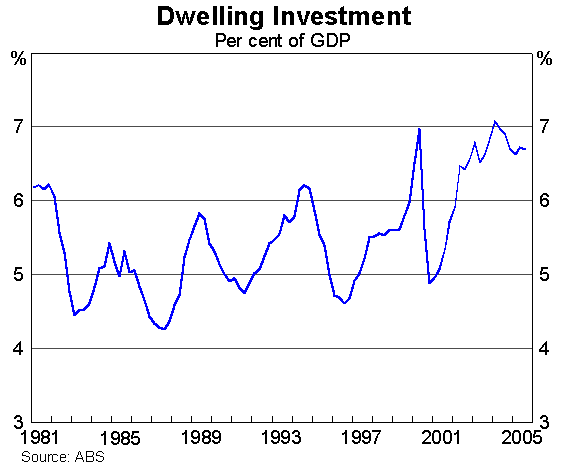
Drawing all this together, what we have been seeing is a change in the composition of growth, with businesses rather than households now the main drivers of growth in domestic spending. This compositional shift in spending is also being reflected in borrowing patterns (Graph 11). Businesses until recently had been much more cautious than households in their borrowing behaviour, and this has put them in a strong position now to borrow more to fund investment growth. The overall change in the composition of spending should be beneficial to prospects for sustainable expansion. A pattern of growth that was heavily skewed towards household spending was not going to be able to continue indefinitely, and the balance-sheet adjustment now occurring in the household sector should reduce the risk of a sharper adjustment later. The increase in business investment now underway will in due course add to the economy's productive capacity. It also offers the prospect of a pick-up in export volumes, particularly in the resources sector.
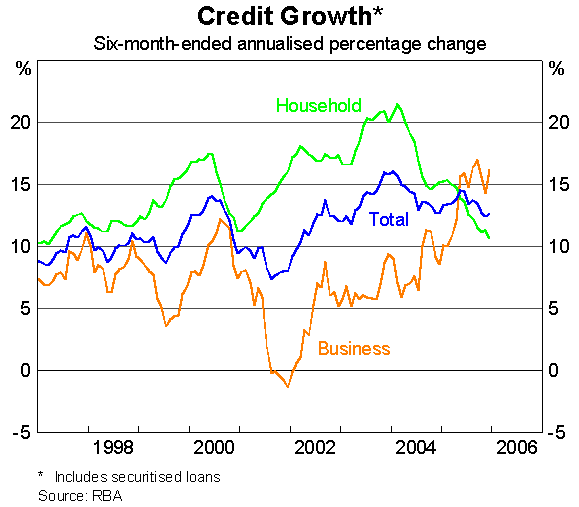
I should conclude, as I often do, by saying that my comments today are not intended to modify the views from the Bank's recent official statements. The net effect of the forces that I have described is that growth of domestic spending has remained solid recently, with overall GDP in the latest six-month period growing at an annual rate of around 3 per cent. The Bank's recently-published assessment is that growth is likely to continue at a similar or higher pace in the period ahead. I hope you will agree that this amounts to a favourable environment for businesses, particularly against the background of an economic expansion now in its fifteenth year.